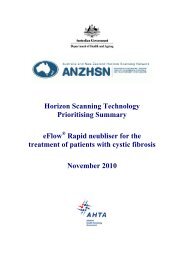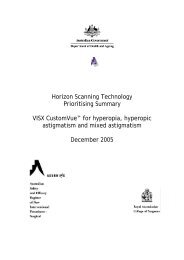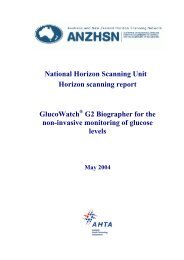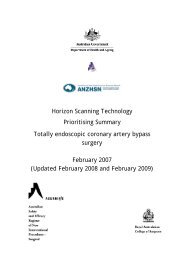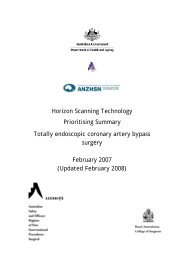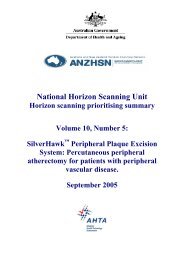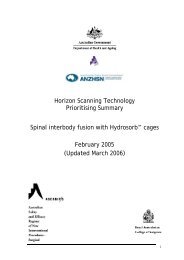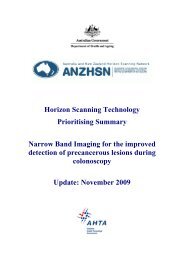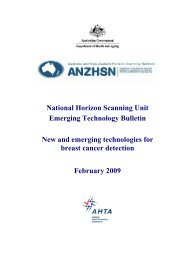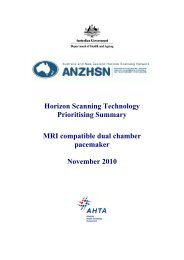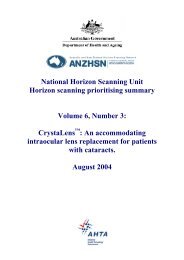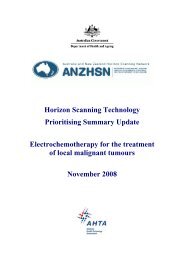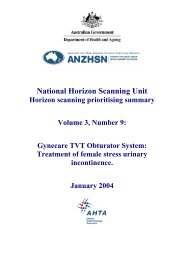Horizon Scanning Technology - the Australia and New Zealand ...
Horizon Scanning Technology - the Australia and New Zealand ...
Horizon Scanning Technology - the Australia and New Zealand ...
You also want an ePaper? Increase the reach of your titles
YUMPU automatically turns print PDFs into web optimized ePapers that Google loves.
<strong>the</strong>re are approxiamtely 40-48,000 stroke events among <strong>Australia</strong>ns. Nearly seven per cent of alldeaths in <strong>Australia</strong> are caused by stroke, with 9,006 deaths from stroke in 2003. During <strong>the</strong> sameperiod approximately 282,600 <strong>Australia</strong>ns with stroke had a disability <strong>and</strong> in 146,400 of <strong>the</strong>seindividuals <strong>the</strong> disability resulted from <strong>the</strong>ir stroke (Senes 2006).In <strong>New</strong> Zeal<strong>and</strong> during 2003-03, <strong>the</strong> prevalence of stroke was 2.1 per cent (95% CI 1.8, 2.4),which corresponds to one in 48 adults having been diagnosed with stroke at some stage in <strong>the</strong>irlives (Ministry of Health 2004).In <strong>Australia</strong> during <strong>the</strong> period 2003-04, <strong>the</strong>re were 40,791 hospital separations forcerebrovascular diseases (ICD 10 coded I60-I69), each involved an average stay of 10.5 days(AIHW 2006). In <strong>New</strong> Zeal<strong>and</strong> during 2001-02 <strong>the</strong>re were 8,787 public hospital separations forcerebrovascular diseases (ICD 10 coded I60-I69), with a mean stay of 43.1 days (<strong>New</strong> Zeal<strong>and</strong>Health Information Service, Ministry of Health).DIFFUSIONAlthough telemedicine is utilised in some clinical areas, to <strong>the</strong> knowledge of <strong>the</strong> Evaluators, it isnot used in <strong>the</strong> diagnosis <strong>and</strong> treatment of stroke patients in <strong>Australia</strong>. The Department ofNeurology in <strong>the</strong> Royal Melbourne Hospital has expressed an interest in using this technology if<strong>the</strong>y had <strong>the</strong> platform (personal communication, Department of Neurology, Royal MelbourneHospital, February 2006).COMPARATORSIn <strong>the</strong> absence of a telemedicine option, treatment of stroke patients should be conductedaccording to <strong>the</strong> recommended National Stroke Foundation Guidelines. Appropriate diagnosis ofstroke <strong>and</strong> immediate referral to a stroke team is important to minimise <strong>the</strong> risk of complicationsin <strong>the</strong> early stages of stroke, <strong>the</strong>refore patients should be triaged <strong>and</strong> responded to in anappropriate manner by emergency or medical staff. However, as <strong>the</strong>se options (CT scan <strong>and</strong>neurologic examination) require <strong>the</strong> interpretation of a specialist, in <strong>the</strong>ir absence appropriatetreatment would include general stroke management including oxygen supplementation forhypoxic patients <strong>and</strong> administration of aspirin if an ischaemic ra<strong>the</strong>r than a haemorrhagic stroke isdiagnosed (National Stroke Foundation 2003).EFFECTIVENESS AND SAFETY ISSUESIn <strong>the</strong> study by Audebert et al (2005), 356 patients presented to <strong>the</strong> emergency departments ofregional hospitals in Bavaria (level IV Diagnostic evidence). Patients were assessed viatelemedicine by specialists working in ei<strong>the</strong>r one of two hospitals which had comprehensivestroke care centres. Mean delay between onset of symptoms <strong>and</strong> hospital admission was 65 ± 25minutes <strong>and</strong> <strong>the</strong> mean time from door-to-needle was 76 ± 24 minutes. The mean time to treatment(administration of tPA) was 141 ± 27 minutes. The average time of <strong>the</strong> teleconsultation was 15.6minutes, with a st<strong>and</strong>ard deviation of 8.2 minutes. Of <strong>the</strong> patients assessed, 106 patients wereeligible to receive thrombolysis with tPA. Of <strong>the</strong> patients excluded from tPA treatment, <strong>the</strong> threehour treatment time window was exceeded before (n=23) or during (n=10) teleconsultation.Audebert et al (2005) et al reported an in-hospital mortality of rate of 10.4% <strong>and</strong> mortality withinseven days of 5.7 per cent. In-hospital mortality from strokes in hospitals within <strong>the</strong> samecommunity, which did not have access to telemedicine, was reported to be 24.1%. This rate wasstatistically higher when compared to <strong>the</strong> rate of hospitals participating in <strong>the</strong> telemedicine trial(p=0.02). Follow-up CT scans were performed after a median of 21 hours administration of tPA3



